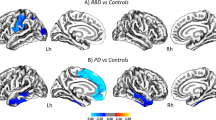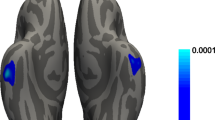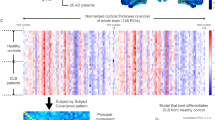Abstract
Narcolepsy with cataplexy is characterized by excessive daytime sleepiness, cataplexy, and other REM sleep phenomena. Previous MRI studies were cross-sectional in design and could not adequately address if disease progression leads the brain structural abnormalities in narcolepsy. Our analysis in patients using longitudinally collected brain MRIs (n = 17; 2 scans per patient; scan interval: 4.7 ± 1.9 years) revealed widespread progressive cortical thinning in bilateral dorsolateral frontal and fusiform cortices, right anterior cingulate (corrected p < 0.05). Cross-sectional analyses showed faster progressive cortical thinning in patients than controls (n = 83, one scan per subject available), which we confirmed significant in the analysis of a small-set of longitudinal control data (n = 10). The pattern of progressive thinning in patients was overlapped well with those found in structural and functional studies of narcolepsy. We also found a faster progression of cortical thinning and worse disease severity (decreased sleep efficiency, increased sleep latency and arousal index) over time in a subgroup of patients with earlier disease onset (n = 9, onset age: 15.9 ± 2.5 years old) compared to later disease onset (n = 8, 25.3 ± 4.9). The faster progressive cortical thinning and worse disease severity over time in the patients with early-onset suggest compelling evidence of disease progression existing in this phenotype of narcolepsy syndrome. Our result based on a small dataset, however, demands a more careful investigation of the underlying mechanism.





Similar content being viewed by others
References
Aguirre, M., Broughton, R., & Stuss, D. (1985). Does memory impairment exist in narcolepsy-cataplexy? Journal of Clinical and Experimental Neuropsychology, 7(1), 14–24. https://doi.org/10.1080/01688638508401239.
Altman, D. G. (2006). The cost of dichotomising continuous variables. BMJ, 332(7549), 1080–1080. https://doi.org/10.1136/bmj.332.7549.1080.
Beck, A. T., Ward, C. H., Mendelson, M., Mock, J., & Erbaugh, J. (1961). An inventory for measuring depression. Archives of General Psychiatry, 4(6), 561–571. https://doi.org/10.1001/archpsyc.1961.01710120031004.
Beck, A. T., Steer, R. A., & Carbin, M. G. (1998). Psychometric properties of the beck depression inventory: Twenty-five years of evaluation. Clinical Psychology Review, 8(1), 77–100. https://doi.org/10.1159/000066239.
Benjamini, Y., & Hochberg, Y. (1995). Controlling the false discovery rate: A practical and powerful approach to multiple testing. Journal of the Royal Statistical Society. Series B …, 57(1), 289–300 http://www.jstor.org/stable/2346101. Accessed 12 May 2014.
Brenneis, C., Brandauer, E., Frauscher, B., Schocke, M., Trieb, T., Poewe, W., & Högl, B. (2005). Voxel-based morphometry in narcolepsy. Sleep Medicine, 6(6), 531–536. https://doi.org/10.1016/j.sleep.2005.03.015.
Chambers, C. D., Payne, J. M., & Mattingley, J. B. (2007). Parietal disruption impairs reflexive spatial attention within and between sensory modalities. Neuropsychologia, 45(8), 1715–1724. https://doi.org/10.1016/j.neuropsychologia.2007.01.001.
Chung, M. K., Wo, K. J., Taylo, J., Rams, J., Robbinst, S., & Evanst, A. C. (2001). Diffusion smoothing on the cortical surface. NeuroImage, 13(6), 2001. https://doi.org/10.1016/S1053-8119(01)91438-7.
Collins, D. L., Neelin, P., Peters, T. M., & Evans, A. C. (1994). Automatic 3D intersubject registration of MR volumetric data in standardized Talairach space. Journal of Computer Assisted Tomography, 18(2), 192–205. https://doi.org/10.1097/00004728-199403000-00005.
Dauvilliers, Y., Montplaisir, J., Molinari, N., Carlander, B., Ondze, B., Besset, A., & Billiard, M. (2001). Age at onset of narcolepsy in two large populations of patients in France and Quebec. Neurology, 57(11), 2029–2033. https://doi.org/10.1212/WNL.57.11.2029.
Dauvilliers, Y., Baumann, C. R., Carlander, B., Bischof, M., Blatter, T., Lecendreux, M., Maly, F., Besset, A., Touchon, J., Billiard, M., Tafti, M., & Bassetti, C. L. (2003). CSF hypocretin-1 levels in narcolepsy, Kleine-Levin syndrome, and other hypersomnias and neurological conditions. Journal of Neurology, Neurosurgery, and Psychiatry, 74(12), 1667–1673. https://doi.org/10.1136/jnnp.74.12.1667.
Dauvilliers, Y., Gosselin, A., Paquet, J., Touchon, J., Billiard, M., & Montplaisir, J. (2004). Effect of age on MSLT results in patients with narcolepsy-cataplexy. Neurology, 62(1), 46–50. https://doi.org/10.1212/01.WNL.0000101725.34089.1E.
Dauvilliers, Y., Arnulf, I., & Mignot, E. (2007). Narcolepsy with cataplexy. Lancet, 369, 499–511. https://doi.org/10.1016/S0140-6736(07)60237-2.
Dauvilliers, Y., Abril, B., Mas, E., Michel, F., & Tafti, M. (2009). Normalization of hypocretin-1 in narcolepsy after intravenous immunoglobulin treatment. Neurology, 73(16), 1333–1334. https://doi.org/10.1212/WNL.0b013e3181bd1344.
Diggle, P. J., Liang, K. Y., & Zegler, S. L. (1995). Analysis of longitudinal data. Oxford Statistical Science Series , 13, 253. https://doi.org/10.1016/S0169-7161(00)18007-1.
Dong, X. S., Li, J., Han, F., Han, X., Jia, F., Wang, L., He, Z. M., & He, Q. Y. (2005). Clinical features of early-onset narcolepsy. Zhonghua Yi Xue Za Zhi, 85(44), 3107–3109 http://www.ncbi.nlm.nih.gov/entrez/query.fcgi?cmd=Retrieve&db=PubMed&dopt=Citation&list_uids=16405812.
Dong, X. S., Ma, S. F., Cao, C. W., Li, J., An, P., Zhao, L., Liu, N. Y., Yan, H., Hu, Q. T., Mignot, E., Strohl, K. P., Gao, Z. C., Zeng, C., & Han, F. (2013). Hypocretin (orexin) neuropeptide precursor gene, HCRT, polymorphisms in early-onset narcolepsy with cataplexy. Sleep Medicine., 14, 482–487. https://doi.org/10.1016/j.sleep.2013.01.016.
Draganski, B., Geisler, P., Hajak, G., Schuierer, G., Bogdahn, U., Winkler, J., & May, A. (2002). Hypothalamic gray matter changes in narcoleptic patients. Nature Medicine, 8(11), 1186–1188. https://doi.org/10.1038/nm1102-1186.
Genovese, C. R., Lazar, N. A., & Nichols, T. (2002). Thresholding of statistical maps in functional neuroimaging using the false discovery rate. Neuroimage, 15(4), 870–878. https://doi.org/10.1006/nimg.2001.1037.
Guilleminault, C., & Dement, W. C. (1977). 235 cases of excessive daytime sleepiness. Diagnosis and tentative classification. Journal of the Neurological Sciences, 31(1), 13–27. https://doi.org/10.1016/0022-510X(77)90003-X.
Henry, G. K., Satz, P., & Heilbronner, R. L. (1993). Evidence of a perceptual-encoding deficit in narcolepsy? Sleep, 16, 123–127.
Hoddes, E., Zarcone, V., Smythe, H., Phillips, R., & Dement, W. C. (1973). Quantification of sleepiness: A new approach. Psychophysiology, 10(4), 431–436. https://doi.org/10.1111/j.1469-8986.1973.tb00801.x.
Hood, B., & Bruck, D. (1996). Sleepiness and performance in narcolepsy. Journal of Sleep Research, 5(2), 128–134.
Im, K., Lee, J.-M., Lyttelton, O., Kim, S. H. I., & Evans, A. C. (2008). Brain size and cortical structure in the adult human brain. Cerebral Cortex, 18(9), 2181–2191. https://doi.org/10.1093/cercor/bhm244.
Johns, M. W. (1991). A new method for measuring daytime sleepiness: The Epworth sleepiness scale. Sleep, 14(6), 540–545.
Joo, E. Y., Tae, W. S., Kim, J. H., Kim, B. T., & Hong, S. B. (2004). Glucose hypometabolism of hypothalamus and thalamus in narcolepsy. Annals of Neurology, 56(3), 437–440. https://doi.org/10.1002/ana.20212.
Joo, E. Y., Hong, S. B., Woo, S. T., Kim, J. H., Han, S. J., Cho, Y. W., et al. (2005). Cerebral perfusion abnormality in narcolepsy with cataplexy. NeuroImage, 28(2), 410–416. https://doi.org/10.1016/j.neuroimage.2005.06.019.
Joo, E. Y., Tae, W. S., Kim, S. T., & Hong, S. B. (2009). Gray matter concentration abnormality in brains of narcolepsy patients. Korean Journal of Radiology, 10(6), 552–558. https://doi.org/10.3348/kjr.2009.10.6.552.
Joo, E. Y., Jeon, S., Lee, M., Kim, S. T., Yoon, U., Koo, D. L., Lee, J. M., & Hong, S. B. (2011). Analysis of cortical thickness in narcolepsy patients with cataplexy. Sleep, 34, 1357–1364. https://doi.org/10.5665/sleep.1278.
Joo, E. Y., Kim, H., Suh, S., & Hong, S. B. (2014). Hippocampal substructural vulnerability to sleep disturbance and cognitive impairment in patients with chronic primary insomnia: Magnetic resonance imaging morphometry. Sleep, 37(7), 1189–1198. https://doi.org/10.5665/sleep.3836.
Kaufmann, C., Schuld, A., Pollmächer, T., & Auer, D. P. (2002). Reduced cortical gray matter in narcolepsy: Preliminary findings with voxel-based morphometry. Neurology, 58(12), 1852–1855. https://doi.org/10.1212/WNL.58.12.1852.
Kim, J. S., Singh, V., Lee, J. K. J. M. J. K. J. M., Lerch, J., Ad-Dab’bagh, Y., MacDonald, D., et al. (2005). Automated 3-D extraction and evaluation of the inner and outer cortical surfaces using a Laplacian map and partial volume effect classification. NeuroImage, 27(1), 210–221. https://doi.org/10.1016/j.neuroimage.2005.03.036.
Kim, S. J., Lyoo, I. K., Lee, Y. S., Lee, J. Y., Yoon, S. J., Kim, J. E., Kim, J. H., Hong, S. J., & Jeong, D. U. (2009). Gray matter deficits in young adults with narcolepsy. Acta Neurologica Scandinavica, 119(1), 61–67. https://doi.org/10.1111/j.1600-0404.2008.01063.x.
Kim, H., Suh, S., Joo, E. Y., & Hong, S. B. (2015). Morphological alterations in amygdalo-hippocampal substructures in narcolepsy patients with cataplexy. Brain Imaging and Behavior., 10, 984–994. https://doi.org/10.1007/s11682-015-9450-0.
Lambe, E. K., Olausson, P., Horst, N. K., Taylor, J. R., & Aghajanian, G. K. (2005). Hypocretin and nicotine excite the same thalamocortical synapses in prefrontal cortex: Correlation with improved attention in rat. The Journal of neuroscience : the official journal of the Society for Neuroscience, 25(21), 5225–5229. https://doi.org/10.1523/JNEUROSCI.0719-05.2005.
Lerch, J. P., Pruessner, J. C., Zijdenbos, A., Hampel, H., Teipel, S. J., & Evans, A. C. (2005). Focal decline of cortical thickness in Alzheimer’s disease identified by computational neuroanatomy. Cerebral Cortex, 15(7), 995–1001. https://doi.org/10.1093/cercor/bhh200.
Lyttelton, O., Boucher, M., Robbins, S., & Evans, A. (2007). An unbiased iterative group registration template for cortical surface analysis. NeuroImage, 34(4), 1535–1544. https://doi.org/10.1016/j.neuroimage.2006.10.041.
MacDonald, D., Kabani, N., Evans, A. C., & Avis, D. (2000). Automated 3-D extraction of inner and outer surfaces of cerebral cortex from MRI. NeuroImage, 12(3), 340–356. https://doi.org/10.1006/nimg.1999.0534.
Mazziotta, J. C., Toga, A. W., Evans, A., Fox, P., & Lancaster, J. (1995). A probabilistic atlas of the human brain: theory and rationale for its development. The International Consortium for Brain Mapping (ICBM). NeuroImage. https://doi.org/10.1006/nimg.1995.1012.
Mignot, E., Hayduk, R., Black, J., Grumet, F. C., & Guilleminault, C. (1997). HLA DQB1*0602 is associated with cataplexy in 509 narcoleptic patients. Sleep, 20(11), 1012–1020.
Noh, H. J., Joo, E. Y., Kim, S. T., Yoon, S. M., Koo, D. L., Kim, D., Lee, G. H., & Hong, S. B. (2012). The relationship between hippocampal volume and cognition in patients with chronic primary insomnia. Journal of Clinical Neurology (Korea), 8(2), 130–138. https://doi.org/10.3988/jcn.2012.8.2.130.
Overeem, S., Steens, S. C. a., Good, C. D., Ferrari, M. D., Mignot, E., Frackowiak, R. S. J., et al. (2003). Voxel-based morphometry in hypocretin-deficient narcolepsy. Sleep, 26(1), 44–46.
Peyron, C., Faraco, J., Rogers, W., Ripley, B., Overeem, S., Charnay, Y., Nevsimalova, S., Aldrich, M., Reynolds, D., Albin, R., Li, R., Hungs, M., Pedrazzoli, M., Padigaru, M., Kucherlapati, M., Fan, J., Maki, R., Lammers, G. J., Bouras, C., Kucherlapati, R., Nishino, S., & Mignot, E. (2000). A mutation in a case of early onset narcolepsy and a generalized absence of hypocretin peptides in human narcoleptic brains. Nature Medicine, 6(9), 991–997. https://doi.org/10.1038/79690.
Pizza, F., Vandi, S., Liguori, R., Parchi, P., Avoni, P., Mignot, E., & Plazzi, G. (2014). Primary progressive narcolepsy type 1: The other side of the coin. Neurology, 83, 2189–2190. https://doi.org/10.1212/WNL.0000000000001051.
Rieger, M., Mayer, G., & Gauggel, S. (2003). Attention deficits in patients with narcolepsy. Sleep, 26(1), 36–43 http://www.ncbi.nlm.nih.gov/entrez/query.fcgi?cmd=Retrieve&db=PubMed&dopt=Citation&list_uids=12627730.
Rocca, F. L., Pizza, F., Ricci, E., & Plazzi, G. (2015). Narcolepsy during childhood: An update. Neuropediatrics, 46, 181–198. https://doi.org/10.1055/s-0035-1550152.
Schaer, M., Poryazova, R., Schwartz, S., Bassetti, C. L., & Baumann, C. R. (2012). Cortical morphometry in narcolepsy with cataplexy. Journal of Sleep Research, 21(5), 487–494. https://doi.org/10.1111/j.1365-2869.2012.01000.x.
Scherfler, C., Frauscher, B., Schocke, M., Nocker, M., Gschliesser, V., Ehrmann, L., Niederreiter, M., Esterhammer, R., Seppi, K., Brandauer, E., Poewe, W., & Högl, B. (2012). White and gray matter abnormalities in narcolepsy with cataplexy. Sleep, 35(3), 345–351. https://doi.org/10.5665/sleep.1692.
Sled, J. G., Zijdenbos, A. P., & Evans, A. C. (1998). A nonparametric method for automatic correction of intensity nonuniformity in MRI data. IEEE Transactions on Medical Imaging, 17(1), 87–97. https://doi.org/10.1109/42.668698.
Snell, R. S. (2010). Clinical neuroanatomy (7th ed.). Philadelphia: Wolters Kluwer Health/Lippincott Williams & Wilkins.
Worsley, K., Taylor, J., Carbonell, F., Chung, M., Duerden, E., Bernhardt, B., Lyttelton, O., Boucher, M., & Evans, A. C. (2009). SurfStat: A Matlab toolbox for the statistical analysis of univariate and multivariate surface and volumetric data using linear mixed effects models and random field theory. NeuroImage, 47, S102. https://doi.org/10.1016/S1053-8119(09)70882-1.
Zijdenbos, a. P., Forghani, R., & Evans, a. C. (2002). Automatic “pipeline” analysis of 3-D MRI data for clinical trials: Application to multiple sclerosis. IEEE Transactions on Medical Imaging, 21(10), 1280–1291. https://doi.org/10.1109/TMI.2002.806283.
Acknowledgements
The authors would like to thank Dr. Felix Carbonell for his consultation and advice in statistical analysis. This study was supported by the Basic Science Research Program through the National Research Foundation of Korea, which is funded by the Ministry of Science, ICT & Future Planning, Republic of Korea (2014R1A1A3049510), by Samsung Biomedical Research Institute grant (SMO1162071), by Donald E. and Delia B. Baxter Foundation Fellowship Awards, by a grant from Canadian Institute of Health Research (CIHR) awarded to Professor Alan C. Evans (201085 & 247003). Dr. Seun Jeon is the recipient of following fellowships that contribute to his support: Bourse Fonds de Recherche Santé Québec (FRQS, dossier 34240 & 259605) and by Jeanne Timmins Costello Fellowship of the Montreal Neurological Institute (240522).
Author information
Authors and Affiliations
Contributions
Seun Jeon performed image processing, statistical analyses, interpretation of data, figure making, and wrote the manuscript. Jae Wook Cho contributed in interpretation of data. Hosung Kim contributed in designing the study, supervised the study, and performed critical revision of the manuscript. Alan C. Evans supervised the study. Seung Bong Hong acquired data. Eun Yeon Joo contributed in designing the study, supervised the study and performed acquisition of the data.
Corresponding authors
Ethics declarations
Conflicts of interest
This was not an industry supported study. The authors have no commercial, financial, or other relationship related to the subject of this paper that could constitute or suggest a conflict of interest.
Ethical approval
All procedures performed in studies involving human participants were in accordance with the ethical standards of the Institutional Review Board of the Samsung Medical Center.
Informed consent
Informed consent was obtained from all individual participants included in the study.
Electronic supplementary material
ESM 1
(DOCX 14726 kb)
Rights and permissions
About this article
Cite this article
Jeon, S., Cho, J.W., Kim, H. et al. A five-year longitudinal study reveals progressive cortical thinning in narcolepsy and faster cortical thinning in relation to early-onset. Brain Imaging and Behavior 14, 200–212 (2020). https://doi.org/10.1007/s11682-018-9981-2
Published:
Issue Date:
DOI: https://doi.org/10.1007/s11682-018-9981-2




